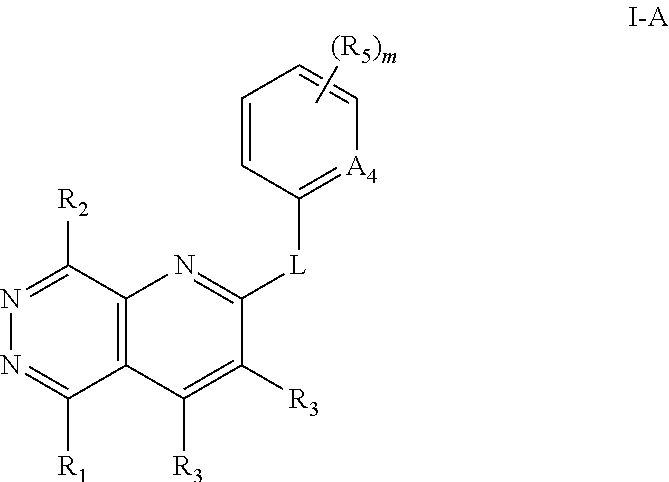Aza- and diaza-phthalazine compounds as P38 map kinase modulators and methods of use thereof
a technology of aza- and diaza-phthalazine compounds and kinase modulators, which is applied in the field of pharmaceutical agents, can solve the problems of joint destructin, pain and disability, and significant neutrophil accumulation in capillaries and adherence in small blood vessels
- Summary
- Abstract
- Description
- Claims
- Application Information
AI Technical Summary
Benefits of technology
Problems solved by technology
Method used
Image
Examples
example 1
[0329]
Synthesis of 5-Chloro-N-(2,4-difluorophenyl)pyrido[3,2-d]pyridazin-2-amine
Step 1: 6-Chloro-2-methylnicotinonitrile
[0330]
[0331]The title compound was prepared according to the procedure described in the literature reference: Synthesis 1991, 10, 894-6.
Step 2: 5-chloro-N-(2,4-difluorophenyl)pyrido[3,2-d]pyridazin-2-amine
[0332]Step 1: A mixture of 6-chloro-2-methylnicotinonitrile (2.01 g, 13 mmol), 2,4-difluorobenzenamine (2.0 mL, 20 mmol), tris(dibenzylideneacetone)dipalladium (0) (0.36 g, 0.40 mmol), 2-dicyclohexylphosphino-2′-(n,n-dimethylamino)biphenyl (0.31 g, 0.79 mmol, Dave-Phos) in 8.0 mL of THF at RT was treated with bis(trimethylsilyl)amino)lithium (28 mL of 1.0 M in THF solution, 28 mmol) drop wise. The mixture was heated at 50° C. in an oil bath for 0.5 h, then cooled to RT, quenched with NH4Cl and diluted with EtOAc. The mixture was filtered through a pad of Celite to remove some Pd black. The filtrate was transferred to a separatory funnel. The EtOAc layer was washed...
example 2
Via Method B
[0336]
Synthesis of N-(2,4-Difluorophenyl)-5-(3,5-dimethylisoxazol-4-yl)pyrido[3,2-d]pyridazin-2-amine
[0337]A mixture of 3,5-dimethyl-4-(4,4,5,5-tetramethyl-1,3,2-dioxaborolan-2-yl)isoxazole (252 mg, 1.12 mmol), 5-chloro-N-(2,4-difluorophenyl)pyrido[3,2-d]pyridazin-2-amine (300 mg, 1.02 mmol) and tetrakis (36 mg, 31 μmol) in 4.0 mL of dioxane and sodium carbonate (2.0 mL of 1 N solution) was heated in a microwave at 130° C. for 35 min. It was diluted with 10 mL of EtOAc and 2.0 mL water and extracted. An additional extraction with DCM (15 mL) was done. The combined extracts and an insoluble tan solid were dried over MgSO4. Filtration through a sintered glass frit washing with 1:1 MeOH:DCM resulted in complete solubilization of the tan solid. The solution was concentrated and washed with Et2O (2×15 mL), EtOAc (15 mL) and hexanes (2×15 mL) to afford a tan amorphous solid which was purified on the ISCO to afford the title compound as a yellow amorphous solid. MS (ESI, pos.io...
example 3
Via Method C
[0338]
Synthesis of N-(2,4-Difluorophenyl)-5-morpholinopyrido[3,2-d]pyridazin-2-amine
[0339]A solution of 5-chloro-N-(2,4-difluorophenyl)pyrido[3,2-d]pyridazin-2-amine (80 mg, 0.27 mmol) and morpholine (238 mg, 2.73 mmol) in 0.4 mL of NMP was heated in a microwave at 150° C. for 30 min. It was diluted with 1 mL of water and stirred for 5 min. The precipitated solid was filtered, rinsed sequentially with 2×2 mL of water, 2×2 mL of ether and 2 mL of EtOAc, then dried in a vacuum oven at 45° C. for 18 h to give the title compound as a tan solid. MS (ESI, pos.ion) m / z: M+1=344.0
PUM
| Property | Measurement | Unit |
|---|---|---|
| flow rate | aaaaa | aaaaa |
| flow rate | aaaaa | aaaaa |
| temperature | aaaaa | aaaaa |
Abstract
Description
Claims
Application Information
 Login to View More
Login to View More - R&D
- Intellectual Property
- Life Sciences
- Materials
- Tech Scout
- Unparalleled Data Quality
- Higher Quality Content
- 60% Fewer Hallucinations
Browse by: Latest US Patents, China's latest patents, Technical Efficacy Thesaurus, Application Domain, Technology Topic, Popular Technical Reports.
© 2025 PatSnap. All rights reserved.Legal|Privacy policy|Modern Slavery Act Transparency Statement|Sitemap|About US| Contact US: help@patsnap.com



